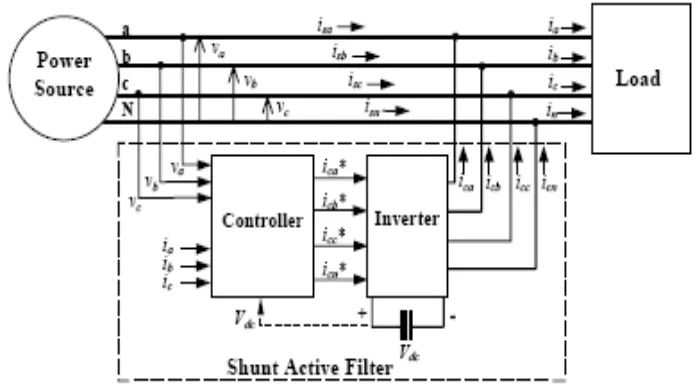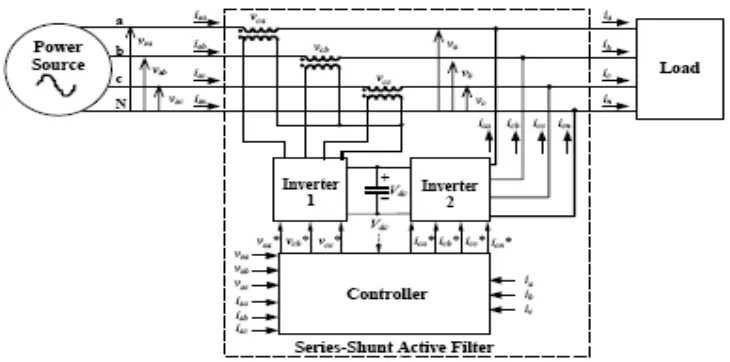Improvement of Power Quality using Active filters
Prof. Vaibhav B. Magdum
1, Prof. Ravindra M. Malkar
21,2
Assistant Professor, Department of Electrical Engineering, DKTE Society’s Textile & Engineering Institute,
Ichalkaranji, (MS), India.
---***---Abstract -Active filtering of electrical energy has become a modern technology for harmonic and reactive power compensation in two-wire (single-phase), three-phase (three-phase without neutral) and four-phase alternating current systems. wires (three phase with neutral) to non-linear grid loads. This document provides a comprehensive analysis of active filter (AF) configurations, control strategies, component selection, other related economic and technical considerations, and their choices for specific applications. It aims to give researchers and application engineers solutions to problems with power quality a broad perspective on the state of AF technology. This document discusses various power quality problems in distribution systems and corrective actions.
Key Words: Active power filters, active power line conditioners, reactive power compensation, power quality.
1. INTRODUCTION
[image:1.595.143.445.413.520.2]The conventionally passive L-C filters were used to reduce harmonics and capacitors were employed to improve the power factor of the ac loads, but they present several disadvantages, namely: they only filter the frequencies they were previously tuned for; their operation cannot be limited to a certain load; resonances can occur because of the interaction between the passive filters and other loads, with unpredictable results. The increased severity of harmonic pollution in power networks has attracted the attention of power electronics and power system engineers to develop dynamic and adjustable solutions to the power quality problems. The equipment developed for this purpose are the Active filters (AF's) [1], also called active power line conditioners (APLC's) connected to the power system with linear and non-linear load as shown in figure 1.
Figure 1. Power system with Shunt Active filter
The presence of harmonics in power lines results in greater power losses in the distribution system, interference problems in communication systems and, sometimes, in operation failures of electronic equipments, which are more and more sensitive since they include microelectronic control systems, which work with very low energy levels. Because of these problems, the issue of the power quality delivered to the end consumers is, more than ever, an object of great concern. International standards concerning electrical power quality impose that electrical equipments and facilities should not produce harmonic contents greater than specified values, and also specify distortion limits to the supply voltage. Meanwhile, it is mandatory to solve the harmonic problems caused by those equipments already installed. These problems can be classified into two kinds: instantaneous effects and long-term effects.
The instantaneous effects problems are associated with interferences, malfunction or performance degradation of equipments and devices.
Long-term effects are of thermal nature and are related, to additional losses and overheating, causing a reduction of the mean lifetime of capacitors, rotating machines and transformers.
2. POWER QUALITY ISSUES AND ITS SOLUTION
2.1 POWER QUALITY PROBLEMS
The following points are indicators of Power Quality problems:
• Between the different voltage disturbances that can be produced, the most significant and critical power quality problems are voltage sags due to the high economical losses that can be generated. Short-term voltage drops (sags) can trip electrical drives or more sensitive equipment, leading to costly interruptions of production [2]
• Piece of equipment misoperates at the same time of day. • Circuit breakers trip without being overloaded.
• Natural phenomena, such as lightning are the most frequent cause of power quality problems. • Automated systems stop for no apparent reason.
• Electronic systems fail or fail to operate on a frequent basis.
• Electronic systems work in one location but not in another location.
The commonly used terms that describe or measure power quality are Voltage sags, Voltage variations, Interruptions Swells, Brownouts, Blackouts, Voltage imbalance, Distortion, Harmonics, Harmonic resonance, Inter harmonics, Notching, Noise, Impulse, Spikes (Voltage), Ground noise, Common mode noise, Critical load, Crest factor, Electromagnetic compatibility, Dropout, Fault, Flicker, Ground, Raw power, Clean ground, Ground loops, Voltage fluctuations, Transient, Dirty power, Momentary interruption, Over voltage, Under voltage, Nonlinear load, THD, Triplens, Voltage dip, Voltage regulation, Blink, Oscillatory transient etc.
For all these reasons, from the consumer point of view, power quality issues will become an increasingly important factor to consider in order to satisfy good productivity. On the other hand, for the electrical supply industry, the quality of power delivered will be one of the distinguishing factor for ensuring customer loyalty in this very competitive and deregulated market. To address the needs of energy consumers trying to improve productivity through the reduction of power quality related process stoppages and energy suppliers trying to maximize operating profits while keeping customers satisfied with supply quality, innovative technology provides the key to cost-effective power quality enhancements solutions. However, with the various power quality solutions available, the obvious question for a consumer or utility facing a particular power quality problem is which equipment provides the better solution.
2.2 SOLUTIONS TO POWER QUALITY PROBLEMS
There are two approaches to the mitigation of power quality problems. The first approach is called load conditioning, which ensures that the equipment is less sensitive to power disturbances, allowing the operation even under significant voltage distortion. The other solution is to install line conditioning systems threes or counteracts the power system disturbances. A flexible and versatile solution to voltage quality problems is offered by active filters. Currently they are based on PWM converters and connect to low and medium voltage distribution system in shunt or in series. Series active filters must operate in conjunction with shunt passive filters in order to compensate load current harmonics. Shunt active filters operate as a controllable current source and series active filters operates as a controllable voltage source. Both schemes are implemented preferable with voltage source PWM inverters, with a dc bus having a reactive element such as a capacitor. Active filters can perform one or more of the functions required to compensate power systems and improving power quality. The selection of the type of active filter to improve power quality depends on the source of the problem as can be seen in Table 1.
TABLE-I: Active Filter Solutions to Power Quality Problems
Active Filter Connection Load on AC Supply AC Supply on Load
Shunt - Current Harmonic Filtering.
-Reactive current compensation. -Current unbalance.
-Voltage Flicker.
Series Current Harmonic Filtering.
3.TECHNIQUES OF POWER QUALITY IMPROVEMENT:
The methods include:
• Proper designing of the Load equipment.
• Application of passive, active and hybrid harmonic filters.
• Proper designing of the power supply system
• Application of voltage compensators.
• Use of uninterruptible power supplies (UPSs)
• Reliability on standby power
4. ACTIVE HARMONIC FILTERS AND CONTROL SCHEMES:
The types of active filters are :
• Shunt type
• Series type.
• Active filters combined with passive filters as well as active filters of both types acting together [3].
[image:3.595.131.480.412.604.2]A. Shunt type
Figure 2: Shunt active filter in a three-phase power system.
The figure shows the electrical scheme of a shunt active filter for a three-phase power system with neutral wire.
• Shunt active filter compensates for current harmonics and perform power factor correction.
• It allows load balancing, by eliminating the current in the neutral wire.
• For balanced loads without 3rd order current harmonics (phase motors, phase adjustable speed drives, three-phase controlled or non-controlled rectifiers, etc) there is no need to compensate for the current in neutral wire as it allows the use of a simpler inverter (with only three legs) and only 4 current sensors which eases the controller calculations.
[image:4.595.119.473.164.349.2]B. Series type
Figure 3: Series active filter in a three-phase power system.
The figure shows the scheme of a series active filter for a three-phase power system.
• It is the dual of the shunt active Filter which can compensate for distortion in the power line voltages, making the voltages applied to the load sinusoidal (compensating for voltage harmonics).
• The filter consists of a voltage-source inverter (behaving as a controlled voltage source) and requires 3 single-phase transformers to interface with the power system.
• The series active filter does not compensate for load current harmonics but it acts as high-impedance to the current harmonics coming from the power source side. Hence, guarantees that passive filters eventually placed at the load input will not drain harmonic currents from the rest of the power system.
C. Series-Shunt type:
Figure 4: Series-shunt active filter in a three-phase power system.
[image:4.595.111.476.549.730.2]It is used to solve the load current harmonics so that both load voltages and the supplied currents become sinusoidal waveforms.
Control schemes:
As per the research [4], there are three methods for control of active filters as listed below
• The FBD Method,
• The Synchronous Reference Method, and
• The p-q Theory.
A. The FBD Method:
1. It decomposes the load currents into power components and powerless components.
2. The goal is to compensate all the terms that do not produce power, but have the drawback of making the power factor less than one.
3. This method calculates an equivalent conductance for the load, given by the ratio between the consumed average power and the squared RMS collective voltage value.
B. The Synchronous Reference Method:
1. This method [8] uses the Park transform.
2. With this transformation the current fundamental orde part will be found in the DC component of the transformed d-q currents, thus making possible its extraction through the use of low-pass filters.
3.Normally active filters have poor performances under non symmetrical and non-sinusoidal voltage conditions. This method presents good response in presence of harmonics on the ac mains voltages and in presence of imbalance.
C. The Active-Reactive (p-q) Theory:
1. It is inherently a three-phase system theory.
2. It can be applied to any three-phase system (balanced or unbalanced, with or without harmonics in both voltages and currents).
3. It is based on instantaneous values, allowing excellent dynamic response.
4. Its calculations are relatively simple (it only includes algebraic expressions that can be implemented using standard processors)
5. CONCLUSION
This paper gives the review about power quality problems, issues and the corrective measures using different means [6]. Utilities are finding it difficult to maintain the power quality at the consumer end, and consumers are paying the penalties indirectly in the form of increased plant downtimes, etc. At present, AF technology is well developed, and many manufacturers are fabricating AF's with large capacities. The utilities in the long run will induce the consumers with nonlinear loads to use the AF's for maintaining the power quality at acceptable levels. A large number of AF configurations are available to compensate harmonic current, reactive power, neutral current, unbalance current, and harmonics which makes the selection of AF’s over other correction techniques.
REFERENCES:
[1] S. Bhattacharya and D. M. Divan, "Hybrid series active/parallel passivepower line conditioner with controlled harmonic injection," U.S. Patent5 465 203, Nov. 1995.
[3] M. Aredes, “Active Power Line Conditioners”, Ph.D. dissertation, Technische Universitat Berlin, 1996.
[4] Active Filters for Power Quality Improvement João L. Afonso, Member IEEE, H. J. Ribeiro da Silva and Júlio. S. Martins, Member IEEE
[5] Bhim Singh, Kamal Al-Haddad, “A Review of Active Filters for Power Quality Improvement” Senior Member, IEEE, and
[6] Power Quality Issues, Problems, Standards & Their Effects In Industry With Corrective Means, S.Khalid & Bharti Dwivedi, Department of Electrical Engineering, I.E.T., Lucknow, India
[7] Trupti.P.Pawale and Namita.N.Kulkarni, KLS’s VDRIT, Haliyal(UK). “Review on Active filters for improvement of Power Quality”
BIOGRAPHIES
Mr. Vaibhav Baburao Magdum is M.E. in Electrical Power system from PVGCOET, Pune (MS). He is B.E. Electrical from AISSMS, COE, Pune, (MS). Presently he is working as Assistant Professor in DKTE Society’s Textile & Engineering Institute, Ichalkaranji, An Autonomous Institute affiliated under Shivaji University, Kolhapur (MS). His research areas include Electrical Machines, Drives, Power System, Switchgear & Protection. He has published and presented the papers in International Journals and International/National conferences. He is a Life member of Indian Society of Technical Education, New Delhi.


